SpringBoot01 InteliJ IDEA安装、Maven配置、创建SpringBoot项目、yml属性配置、多环境配置、自定义properties配置
1 IntelliJ IDEA 安装
下载地址:点击前往

注意:需要下载专业版本的,注册码在网上随便搜一个就行啦
2 MAVEN工具的安装
2.1 获取安装包
下载地址:点击前往

2.2 安装过程
到官网下载的maven是绿色版的,无需安装,解压即可

2.3 修改maven的配置
2.3.1 配置maven的本地仓库路径
<localRepository>D://PTool/maven/apache-maven-3.5.0/conf/bdck</localRepository>
2.3.2 配置maven的远程仓库地址
<mirror> <id>aliyun</id> <name>aliyun Maven</name> <mirrorOf>*</mirrorOf> <url>http://maven.aliyun.com/nexus/content/groups/public/</url> </mirror>
注意:这两个配置都只需要在setting.xml中设置就可以啦


1 <?xml version="1.0" encoding="UTF-8"?> 2 3 <!-- 4 Licensed to the Apache Software Foundation (ASF) under one 5 or more contributor license agreements. See the NOTICE file 6 distributed with this work for additional information 7 regarding copyright ownership. The ASF licenses this file 8 to you under the Apache License, Version 2.0 (the 9 "License"); you may not use this file except in compliance 10 with the License. You may obtain a copy of the License at 11 12 http://www.apache.org/licenses/LICENSE-2.0 13 14 Unless required by applicable law or agreed to in writing, 15 software distributed under the License is distributed on an 16 "AS IS" BASIS, WITHOUT WARRANTIES OR CONDITIONS OF ANY 17 KIND, either express or implied. See the License for the 18 specific language governing permissions and limitations 19 under the License. 20 --> 21 22 <!-- 23 | This is the configuration file for Maven. It can be specified at two levels: 24 | 25 | 1. User Level. This settings.xml file provides configuration for a single user, 26 | and is normally provided in ${user.home}/.m2/settings.xml. 27 | 28 | NOTE: This location can be overridden with the CLI option: 29 | 30 | -s /path/to/user/settings.xml 31 | 32 | 2. Global Level. This settings.xml file provides configuration for all Maven 33 | users on a machine (assuming they're all using the same Maven 34 | installation). It's normally provided in 35 | ${maven.home}/conf/settings.xml. 36 | 37 | NOTE: This location can be overridden with the CLI option: 38 | 39 | -gs /path/to/global/settings.xml 40 | 41 | The sections in this sample file are intended to give you a running start at 42 | getting the most out of your Maven installation. Where appropriate, the default 43 | values (values used when the setting is not specified) are provided. 44 | 45 |--> 46 <settings xmlns="http://maven.apache.org/SETTINGS/1.0.0" 47 xmlns:xsi="http://www.w3.org/2001/XMLSchema-instance" 48 xsi:schemaLocation="http://maven.apache.org/SETTINGS/1.0.0 http://maven.apache.org/xsd/settings-1.0.0.xsd"> 49 <!-- localRepository 50 | The path to the local repository maven will use to store artifacts. 51 | 52 | Default: ${user.home}/.m2/repository 53 <localRepository>/path/to/local/repo</localRepository> 54 --> 55 <localRepository>D://PTool/maven/apache-maven-3.5.0/conf/bdck</localRepository> 56 57 58 <!-- interactiveMode 59 | This will determine whether maven prompts you when it needs input. If set to false, 60 | maven will use a sensible default value, perhaps based on some other setting, for 61 | the parameter in question. 62 | 63 | Default: true 64 <interactiveMode>true</interactiveMode> 65 --> 66 67 <!-- offline 68 | Determines whether maven should attempt to connect to the network when executing a build. 69 | This will have an effect on artifact downloads, artifact deployment, and others. 70 | 71 | Default: false 72 <offline>false</offline> 73 --> 74 75 <!-- pluginGroups 76 | This is a list of additional group identifiers that will be searched when resolving plugins by their prefix, i.e. 77 | when invoking a command line like "mvn prefix:goal". Maven will automatically add the group identifiers 78 | "org.apache.maven.plugins" and "org.codehaus.mojo" if these are not already contained in the list. 79 |--> 80 <pluginGroups> 81 <!-- pluginGroup 82 | Specifies a further group identifier to use for plugin lookup. 83 <pluginGroup>com.your.plugins</pluginGroup> 84 --> 85 </pluginGroups> 86 87 <!-- proxies 88 | This is a list of proxies which can be used on this machine to connect to the network. 89 | Unless otherwise specified (by system property or command-line switch), the first proxy 90 | specification in this list marked as active will be used. 91 |--> 92 <proxies> 93 <!-- proxy 94 | Specification for one proxy, to be used in connecting to the network. 95 | 96 <proxy> 97 <id>optional</id> 98 <active>true</active> 99 <protocol>http</protocol> 100 <username>proxyuser</username> 101 <password>proxypass</password> 102 <host>proxy.host.net</host> 103 <port>80</port> 104 <nonProxyHosts>local.net|some.host.com</nonProxyHosts> 105 </proxy> 106 --> 107 </proxies> 108 109 <!-- servers 110 | This is a list of authentication profiles, keyed by the server-id used within the system. 111 | Authentication profiles can be used whenever maven must make a connection to a remote server. 112 |--> 113 <servers> 114 <!-- server 115 | Specifies the authentication information to use when connecting to a particular server, identified by 116 | a unique name within the system (referred to by the 'id' attribute below). 117 | 118 | NOTE: You should either specify username/password OR privateKey/passphrase, since these pairings are 119 | used together. 120 | 121 <server> 122 <id>deploymentRepo</id> 123 <username>repouser</username> 124 <password>repopwd</password> 125 </server> 126 --> 127 128 <!-- Another sample, using keys to authenticate. 129 <server> 130 <id>siteServer</id> 131 <privateKey>/path/to/private/key</privateKey> 132 <passphrase>optional; leave empty if not used.</passphrase> 133 </server> 134 --> 135 </servers> 136 137 <!-- mirrors 138 | This is a list of mirrors to be used in downloading artifacts from remote repositories. 139 | 140 | It works like this: a POM may declare a repository to use in resolving certain artifacts. 141 | However, this repository may have problems with heavy traffic at times, so people have mirrored 142 | it to several places. 143 | 144 | That repository definition will have a unique id, so we can create a mirror reference for that 145 | repository, to be used as an alternate download site. The mirror site will be the preferred 146 | server for that repository. 147 |--> 148 <mirrors> 149 <!-- mirror 150 | Specifies a repository mirror site to use instead of a given repository. The repository that 151 | this mirror serves has an ID that matches the mirrorOf element of this mirror. IDs are used 152 | for inheritance and direct lookup purposes, and must be unique across the set of mirrors. 153 | 154 <mirror> 155 <id>mirrorId</id> 156 <mirrorOf>repositoryId</mirrorOf> 157 <name>Human Readable Name for this Mirror.</name> 158 <url>http://my.repository.com/repo/path</url> 159 </mirror> 160 --> 161 <mirror> 162 <id>aliyun</id> 163 <name>aliyun Maven</name> 164 <mirrorOf>*</mirrorOf> 165 <url>http://maven.aliyun.com/nexus/content/groups/public/</url> 166 </mirror> 167 </mirrors> 168 169 <!-- profiles 170 | This is a list of profiles which can be activated in a variety of ways, and which can modify 171 | the build process. Profiles provided in the settings.xml are intended to provide local machine- 172 | specific paths and repository locations which allow the build to work in the local environment. 173 | 174 | For example, if you have an integration testing plugin - like cactus - that needs to know where 175 | your Tomcat instance is installed, you can provide a variable here such that the variable is 176 | dereferenced during the build process to configure the cactus plugin. 177 | 178 | As noted above, profiles can be activated in a variety of ways. One way - the activeProfiles 179 | section of this document (settings.xml) - will be discussed later. Another way essentially 180 | relies on the detection of a system property, either matching a particular value for the property, 181 | or merely testing its existence. Profiles can also be activated by JDK version prefix, where a 182 | value of '1.4' might activate a profile when the build is executed on a JDK version of '1.4.2_07'. 183 | Finally, the list of active profiles can be specified directly from the command line. 184 | 185 | NOTE: For profiles defined in the settings.xml, you are restricted to specifying only artifact 186 | repositories, plugin repositories, and free-form properties to be used as configuration 187 | variables for plugins in the POM. 188 | 189 |--> 190 <profiles> 191 <!-- profile 192 | Specifies a set of introductions to the build process, to be activated using one or more of the 193 | mechanisms described above. For inheritance purposes, and to activate profiles via <activatedProfiles/> 194 | or the command line, profiles have to have an ID that is unique. 195 | 196 | An encouraged best practice for profile identification is to use a consistent naming convention 197 | for profiles, such as 'env-dev', 'env-test', 'env-production', 'user-jdcasey', 'user-brett', etc. 198 | This will make it more intuitive to understand what the set of introduced profiles is attempting 199 | to accomplish, particularly when you only have a list of profile id's for debug. 200 | 201 | This profile example uses the JDK version to trigger activation, and provides a JDK-specific repo. 202 <profile> 203 <id>jdk-1.4</id> 204 205 <activation> 206 <jdk>1.4</jdk> 207 </activation> 208 209 <repositories> 210 <repository> 211 <id>jdk14</id> 212 <name>Repository for JDK 1.4 builds</name> 213 <url>http://www.myhost.com/maven/jdk14</url> 214 <layout>default</layout> 215 <snapshotPolicy>always</snapshotPolicy> 216 </repository> 217 </repositories> 218 </profile> 219 --> 220 221 <!-- 222 | Here is another profile, activated by the system property 'target-env' with a value of 'dev', 223 | which provides a specific path to the Tomcat instance. To use this, your plugin configuration 224 | might hypothetically look like: 225 | 226 | ... 227 | <plugin> 228 | <groupId>org.myco.myplugins</groupId> 229 | <artifactId>myplugin</artifactId> 230 | 231 | <configuration> 232 | <tomcatLocation>${tomcatPath}</tomcatLocation> 233 | </configuration> 234 | </plugin> 235 | ... 236 | 237 | NOTE: If you just wanted to inject this configuration whenever someone set 'target-env' to 238 | anything, you could just leave off the <value/> inside the activation-property. 239 | 240 <profile> 241 <id>env-dev</id> 242 243 <activation> 244 <property> 245 <name>target-env</name> 246 <value>dev</value> 247 </property> 248 </activation> 249 250 <properties> 251 <tomcatPath>/path/to/tomcat/instance</tomcatPath> 252 </properties> 253 </profile> 254 --> 255 </profiles> 256 257 <!-- activeProfiles 258 | List of profiles that are active for all builds. 259 | 260 <activeProfiles> 261 <activeProfile>alwaysActiveProfile</activeProfile> 262 <activeProfile>anotherAlwaysActiveProfile</activeProfile> 263 </activeProfiles> 264 --> 265 </settings>
2.3.3 配置maven的环境变量
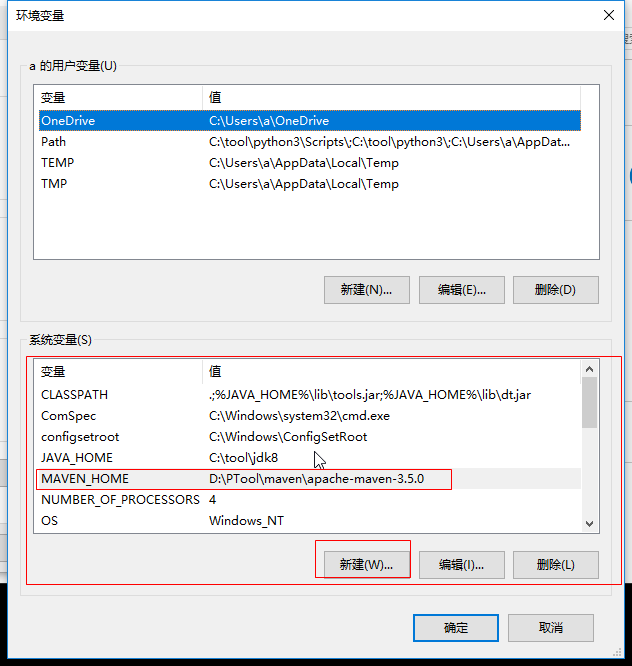

注意:配置maven的环境变量前请配置好Java的环境变量
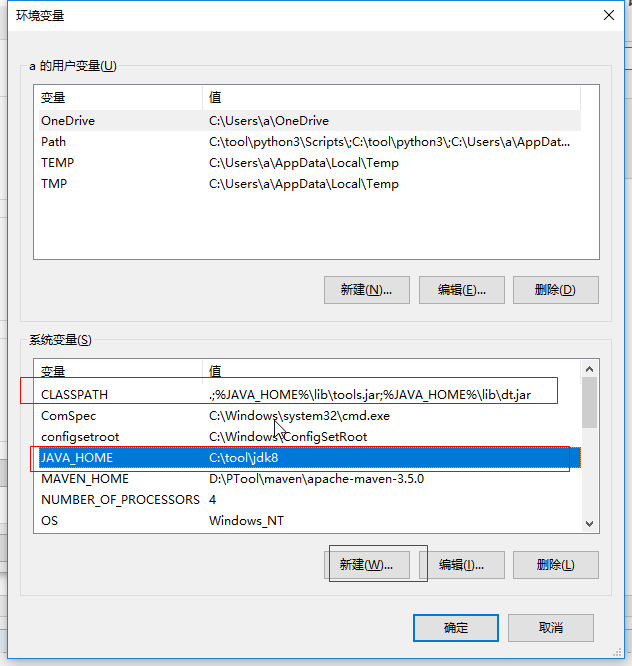
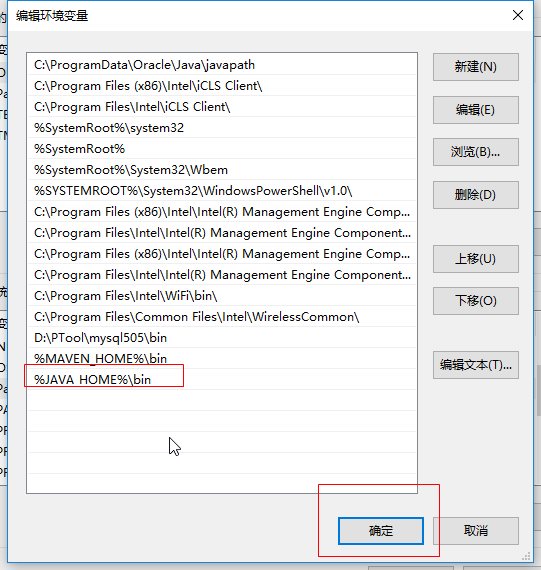
配置完环境变量后再dos窗口中执行:mvn -v 查看版本

3 在 InteliJ IDEA 中配置maven
配置信息看图即可

4 创建SpringBoot项目
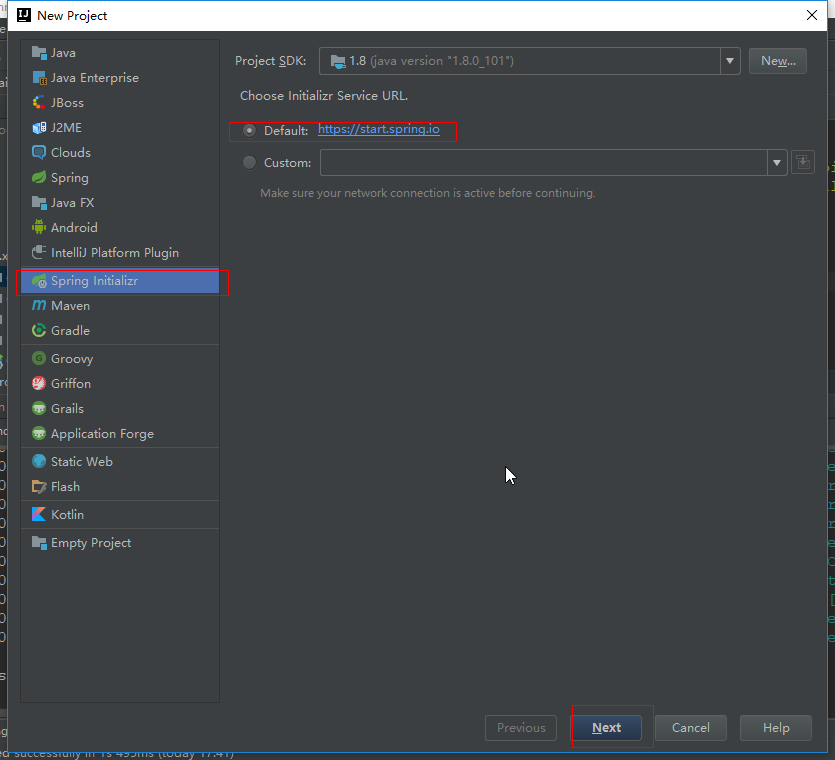
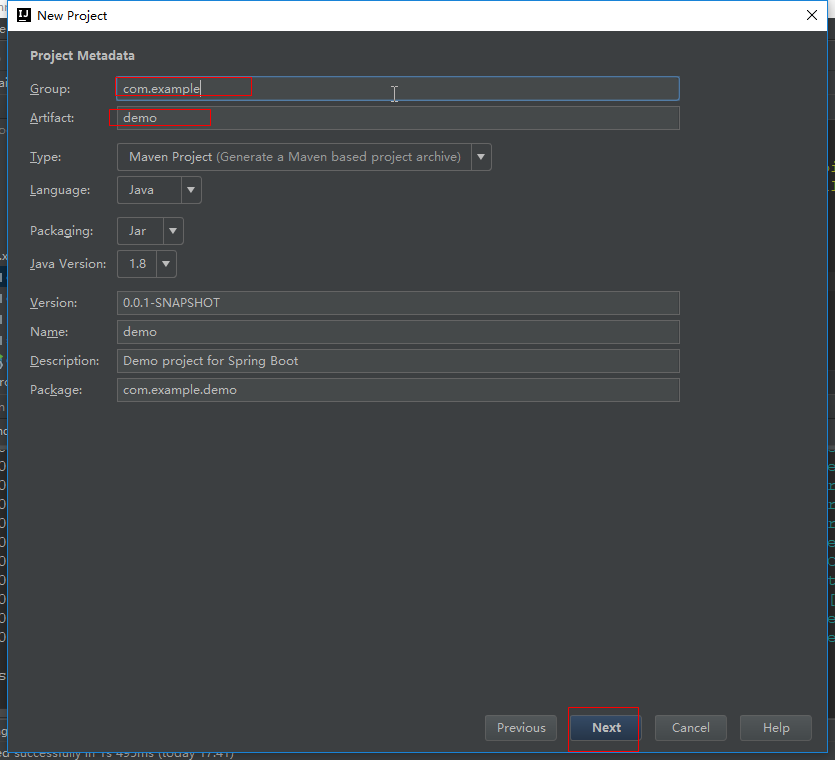
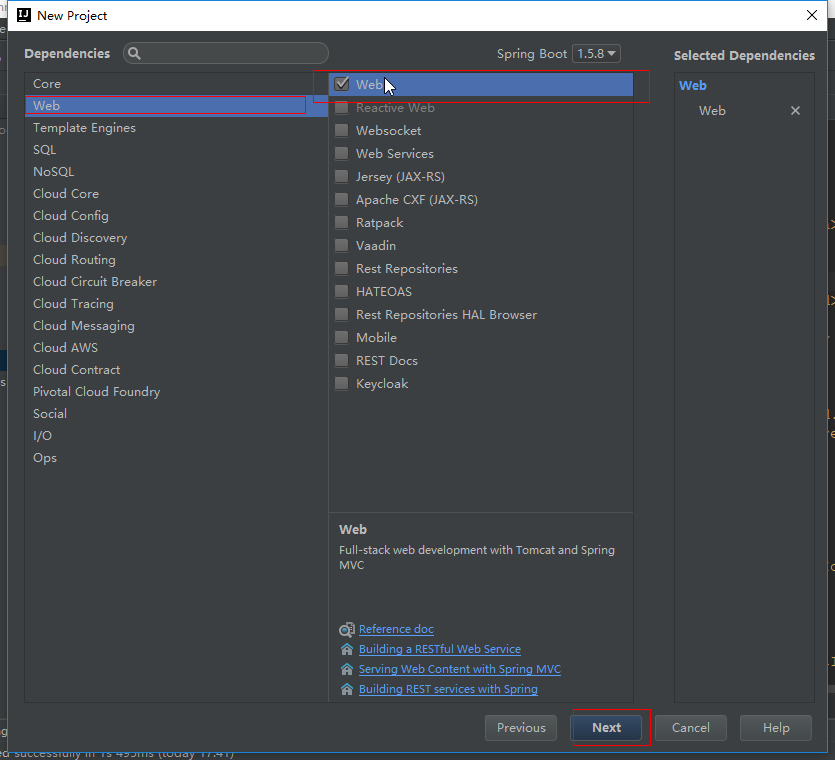
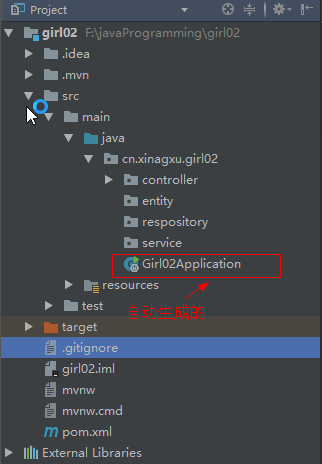
注意:会自动生成一个包含main函数的应用入口类

package cn.xinagxu.girl02; import org.springframework.boot.SpringApplication; import org.springframework.boot.autoconfigure.SpringBootApplication; @SpringBootApplication public class Girl02Application { public static void main(String[] args) { SpringApplication.run(Girl02Application.class, args); } }
注意:创建好的springboot项目的pom.xml文件已经自动引入了两个依赖和一个插件

<?xml version="1.0" encoding="UTF-8"?> <project xmlns="http://maven.apache.org/POM/4.0.0" xmlns:xsi="http://www.w3.org/2001/XMLSchema-instance" xsi:schemaLocation="http://maven.apache.org/POM/4.0.0 http://maven.apache.org/xsd/maven-4.0.0.xsd"> <modelVersion>4.0.0</modelVersion> <groupId>cn.xinagxu</groupId> <artifactId>girl02</artifactId> <version>0.0.1-SNAPSHOT</version> <packaging>jar</packaging> <name>girl02</name> <description>Demo project for Spring Boot</description> <parent> <groupId>org.springframework.boot</groupId> <artifactId>spring-boot-starter-parent</artifactId> <version>1.5.8.RELEASE</version> <relativePath/> <!-- lookup parent from repository --> </parent> <properties> <project.build.sourceEncoding>UTF-8</project.build.sourceEncoding> <project.reporting.outputEncoding>UTF-8</project.reporting.outputEncoding> <java.version>1.8</java.version> </properties> <dependencies> <dependency> <groupId>org.springframework.boot</groupId> <artifactId>spring-boot-starter-web</artifactId> </dependency> <dependency> <groupId>org.springframework.boot</groupId> <artifactId>spring-boot-starter-test</artifactId> <scope>test</scope> </dependency> </dependencies> <build> <plugins> <plugin> <groupId>org.springframework.boot</groupId> <artifactId>spring-boot-maven-plugin</artifactId> </plugin> </plugins> </build> </project>
福利:SpringBoot项目脚手架 -> 点击前往
该脚手架包含的东西
》开发热部署
》日志文件配置;注意:日志文件配置在static中的logback-spring.xml,如果要使用将这个配置文件移动到resources目录下后进入该配置文件修改日志存放路径即可使用
》多环境配置;注意:默认使用的是开发环境
》数据库配置;注意:使用的mysql数据库
4.1 利用springBoot项目编写一个hello world
编写一个controller类,当前段请求为 http://127.0.0.1:8080/ 时以JSON格式放回 Hello World!

package cn.xinagxu.girl02.controller; import org.springframework.web.bind.annotation.RequestMapping; import org.springframework.web.bind.annotation.RestController; @RestController public class HelloController { @RequestMapping(value = "/") public String hello() { return "Hello World!"; } }
注意:@RestController = @Controller + @ResponseBody
4.2 启动应用
4.2.1 直接在应用入口类中点击右键运行即可

4.2.2 利用maven启动
进入到项目的根目录后执行
mnv spring-boot:run

4.2.3 利用maven启动方式2
进入到醒目根目录
执行 mvn install 编译项目

再去到 target 目录下 cd target
注意:target目录存放的都是编译过后的文件
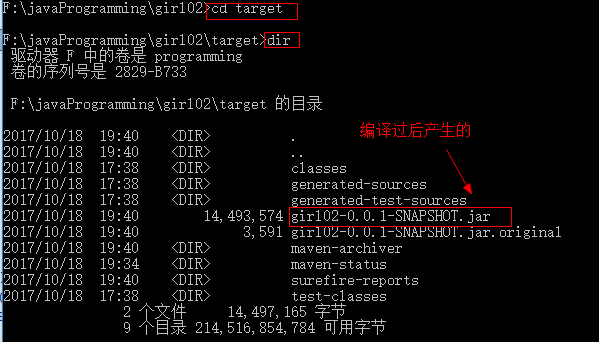
再利用 java -jar 项目名.jar

5 属性配置
5.1 springBoot支持两种方式的配置文件
properties yml
配置上下文路径为 /girl02
配置端口为:8888

server.context-path=/girl02
server.port=8888

server:
context-path: /girl
port: 9999
注意:yml的配置时冒号后面必须加一个空格;推荐使用yml格式的配置方式
5.2 单个的属性配置
在配置文件中配置变量以及变量值
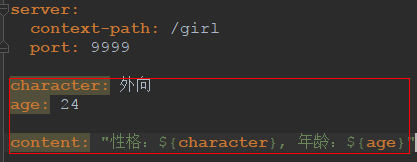
在需要用到的地方引入这个属性,类似于从容器中引入对象一样
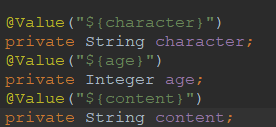

package cn.xinagxu.girl02.controller; import org.springframework.beans.factory.annotation.Value; import org.springframework.stereotype.Controller; import org.springframework.web.bind.annotation.RequestMapping; import org.springframework.web.bind.annotation.ResponseBody; import org.springframework.web.bind.annotation.RestController; @RestController @Controller @ResponseBody public class HelloController { @Value("${character}") private String character; @Value("${age}") private Integer age; @Value("${content}") private String content; @RequestMapping(value = "/") public String hello() { return "Hello World!" + "性格:" + character + " 年龄:" + age + " 详细信息为:" + content; } }
5.3 将一个对象作为单个属性进行配置
编写一个实体类

package cn.xinagxu.girl02.entity; import org.springframework.boot.context.properties.ConfigurationProperties; import org.springframework.stereotype.Component; @Component @ConfigurationProperties(prefix = "student") public class Student { private Integer id; private String name; private Integer age; public Student() { } public Integer getId() { return id; } public void setId(Integer id) { this.id = id; } public String getName() { return name; } public void setName(String name) { this.name = name; } public Integer getAge() { return age; } public void setAge(Integer age) { this.age = age; } @Override public String toString() { return "Student{" + "id=" + id + ", name='" + name + '\'' + ", age=" + age + '}'; } }
在配置文件中配置实体类的属性值
类似于给一个实体bean赋值
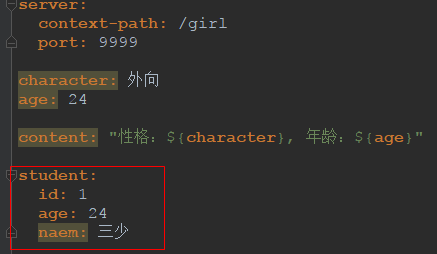
在用到的地方引入这个实体类


package cn.xinagxu.girl02.controller; import cn.xinagxu.girl02.entity.Student; import org.springframework.beans.factory.annotation.Autowired; import org.springframework.beans.factory.annotation.Value; import org.springframework.stereotype.Controller; import org.springframework.web.bind.annotation.RequestMapping; import org.springframework.web.bind.annotation.ResponseBody; import org.springframework.web.bind.annotation.RestController; @RestController @Controller @ResponseBody public class HelloController { @Value("${character}") private String character; @Value("${age}") private Integer age; @Value("${content}") private String content; @Autowired private Student student; @RequestMapping(value = "/") public String hello() { // return "Hello World!" + "性格:" + character + " 年龄:" + age + " 详细信息为:" + content; return student.toString(); } }
5.4 坑:在工具类中如何获取配置文件信息
获取方式不变,但是如果使用new去创建工具实例,那么工具类中就不会获取到相关的配置文件信息;必须将配置类被容器管理,然后在需要使用配置类的地方依赖注入即可;否则读取到的配置信息全部都是null;参考博文

package cn.xiangxu.redis_demo.common.uitls; import org.springframework.beans.factory.annotation.Value; import org.springframework.stereotype.Component; import redis.clients.jedis.Jedis; /** * @author 王杨帅 * @create 2018-06-25 13:35 * @desc jedis客户端工具类 **/ @Component public class JedisClientUtil { @Value("${spring.redis.host}") private String host; @Value("${spring.redis.port}") private Integer port; private final byte[] temp_lock = new byte[1]; private Jedis jedis; public JedisClientUtil(){} public Jedis getRedisClient() { if (jedis == null) { synchronized (temp_lock) { if (jedis == null) { System.out.println(host); System.out.println(port); jedis = new Jedis(host,port); } } } return jedis; } }


package cn.xiangxu.redis_demo.web; import cn.xiangxu.redis_demo.common.uitls.JedisClientUtil; import lombok.extern.slf4j.Slf4j; import org.junit.jupiter.api.Test; import org.springframework.beans.factory.annotation.Autowired; import org.springframework.beans.factory.annotation.Value; import org.springframework.web.bind.annotation.GetMapping; import org.springframework.web.bind.annotation.RequestMapping; import org.springframework.web.bind.annotation.RestController; import redis.clients.jedis.Jedis; import redis.clients.jedis.JedisPool; import redis.clients.jedis.JedisPoolConfig; /** * @author 王杨帅 * @create 2018-06-25 13:35 * @desc Redis相关 **/ @RestController @RequestMapping(value = "/redis") @Slf4j public class RedisController { /** * 单例模式 */ @Test public void test01() { // 01 获取Jedis客户端【设置IP和端口】 Jedis jedis = new Jedis("192.168.233.134", 6379); // 02 保存数据 jedis.set("name", "王杨帅"); // 03 获取数据 String value = jedis.get("name"); System.out.println("获取到的数据为:" + value); String age = jedis.get("age"); System.out.println("获取到的年龄信息为:" + age); // 04 释放资源 jedis.close(); } /** * 使用连接池模式 */ @Test public void test02() { System.out.println("Hello Warrior"); // 01 获取连接池对象 JedisPoolConfig config = new JedisPoolConfig(); // 0101 最大连接数 config.setMaxTotal(30); // 0102 最大空闲连接数 config.setMaxIdle(10); // 02 获取连接池 JedisPool jedisPool = new JedisPool(config, "192.168.233.134", 6379); // 03 核心对象【获取Jedis客户端对象】 Jedis jedis = null; try { // 0301 通过连接池获取Jedis客户端 jedis = jedisPool.getResource(); // 0302 设置数据 jedis.set("name", "三少"); // 0303 获取数据 String value = jedis.get("name"); System.out.println(value); } catch (Exception e) { // TODO: handle exception e.printStackTrace(); } finally { if (jedis != null) { jedis.close(); } if (jedisPool != null) { jedisPool.close(); } } } @Autowired private JedisClientUtil jedisClientUtil; @GetMapping(value = "/connect") public void connect() { // JedisClientUtil jedisClientUtil = new JedisClientUtil(); Jedis jedis = jedisClientUtil.getRedisClient(); } }
6 多环境配置

注意:前面两个配置文件中配置的东西是公用的,后面两个中一个是开发环境,一个是生产环境


#server: # context-path: /girl # port: 9999 spring: profiles: active: prod character: 外向 age: 24 content: "性格:${character}, 年龄:${age}" student: id: 1 age: 24 naem: 三少

server: context-path: /girl port: 9999

server: context-path: /girl port: 8888
6.1 同时在启动两个环境
在IntelliJ IDEA中启动主配置中指定的那个环境
利用maven启动项目,并指定运行环境
java -jar 项目名.jar --spring.profiles.active=prod
注意:运行前需要编译项目然后进入到target文件夹中
7 自定义properties配置
7.1 properties配置文件
在properties配置文件中配置一个自定义配置,例如
xiangxu.security.browser.loginPage = /demo-signIn.html
7.2 创建一个SecurityProperty对象
该对象是用来保存properties配置文件中以 xiangxu.security开始的所有配置信息
技巧01:需要在该实体类上标注 @ConfigurationProperties(prefix = "xiangxu.security") 注解来声明该实体类是用来保存properties配置文件中以 xiangxu.security开始的所有配置信息
技巧02:该对象中有一个名为browser的实体属性,该属性是用来存放在properties文件中以browser开始的配置信息
技巧03:在properties文件中xiangxu.security的配置信息属性名必须和SecurityProperty对象的实例属性名保持一致
技巧04:如果给实体类的属性设定了默认值后,如果在配置文件中没有对应的配置就会使用属性对应的默认值作为默认配置
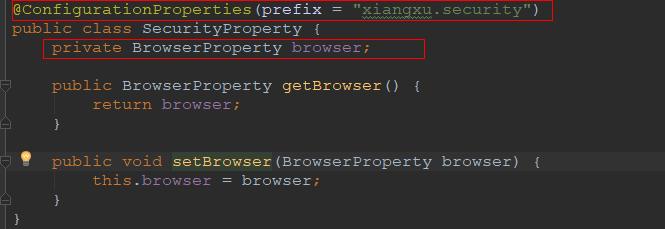

package com.example.wiremock.entity.properties; import org.springframework.boot.context.properties.ConfigurationProperties; /** * @author 王杨帅 * @create 2018-05-13 13:45 * @desc **/ @ConfigurationProperties(prefix = "xiangxu.security") public class SecurityProperty { private BrowserProperty browser; public BrowserProperty getBrowser() { return browser; } public void setBrowser(BrowserProperty browser) { this.browser = browser; } }
7.3 创建 BrowserProperty 对象
该对象是用来存放propertes文件中browser开始的配置信息
技巧01:properties配置文件中browser后面的属性名必须和实体类BrowserProperty的实例属性名一致


package com.example.wiremock.entity.properties; /** * @author 王杨帅 * @create 2018-05-13 13:46 * @desc **/ public class BrowserProperty { private String loginPage; public String getLoginPage() { return loginPage; } public void setLoginPage(String loginPage) { this.loginPage = loginPage; } }
7.4 SpringBoot配置类
创建一个配置类,来让我们定义的实体类和properties配置文件中的配置信息对应起来;这样我们只需要依赖注入我们创建的实体类SecurityProperty就可以读取到properties中的配置信息了


package com.example.wiremock.config; import com.example.wiremock.entity.properties.SecurityProperty; import org.springframework.boot.context.properties.EnableConfigurationProperties; import org.springframework.context.annotation.Configuration; @Configuration @EnableConfigurationProperties(SecurityProperty.class) public class PropertiesConfig { }
7.5 测试类
项目启动后依赖注入配置实体类后,就可以通过依赖注入的对象去获取到对应的propertes配置信息

package com.example.wiremock.controller; import com.example.wiremock.entity.properties.SecurityProperty; import lombok.extern.slf4j.Slf4j; import org.apache.commons.lang.builder.ReflectionToStringBuilder; import org.apache.commons.lang.builder.ToStringStyle; import org.junit.Test; import org.junit.runner.RunWith; import org.springframework.beans.factory.annotation.Autowired; import org.springframework.boot.test.context.SpringBootTest; import org.springframework.test.context.junit4.SpringRunner; /** * @author 王杨帅 * @create 2018-05-13 14:15 * @desc **/ @RunWith(SpringRunner.class) @SpringBootTest @Slf4j public class PropertiesTest { // 01 依赖注入配置实体类 @Autowired private SecurityProperty securityProperty; @Test public void test01() { log.info(ReflectionToStringBuilder.toString(securityProperty, ToStringStyle.MULTI_LINE_STYLE)); log.info(securityProperty.getBrowser().getLoginPage()); } }
·下面是我的公众号二维码,欢迎关注·
尋渝記

微信号:xyj_fury



